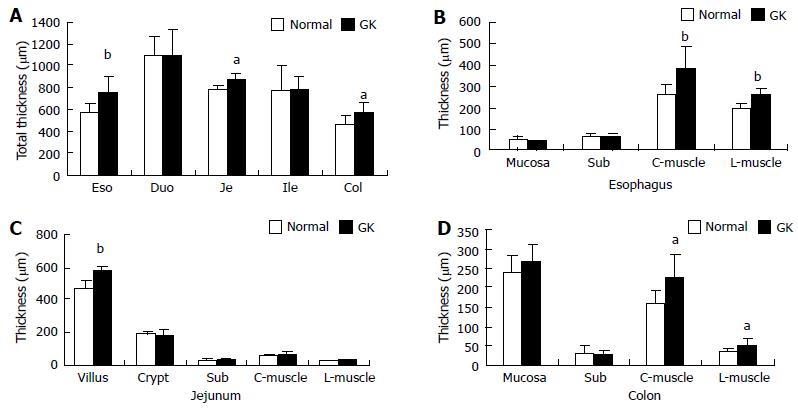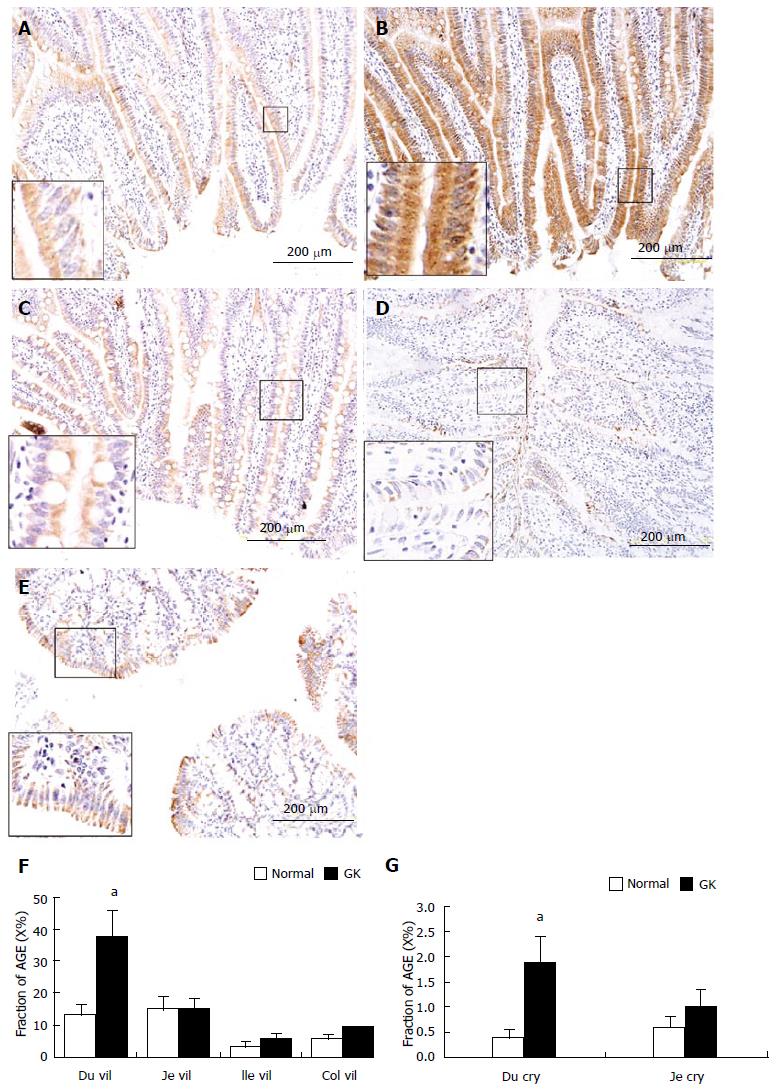Copyright
©The Author(s) 2015.
World J Diabetes. May 15, 2015; 6(4): 662-672
Published online May 15, 2015. doi: 10.4239/wjd.v6.i4.662
Published online May 15, 2015. doi: 10.4239/wjd.v6.i4.662
Figure 1 Body weight (A) and the blood glucose level (B) were higher in Goto-Kakizak group than in the normal group (P < 0.
001 and P < 0.01). The wet weight per unit length of intestinal and colon segments is shown in Figure 1C (compared with normal group: aP < 0.05, bP < 0.01). Values are mean ± SD, n = 8 for each group. Eso: Esophagus; Duo: Duodenum; Je: Jejunum; Ile: Ileum; Col: Colon; GK: Inherited type 2 diabetic Goto-Kakizak rats.
Figure 2 The wall and layer thickness.
A: Total wall thickness; B: Layer thickness of esophagus; C: Layer thickness of jejunum; D: Layer thickness of colon. Values are mean ± SD, n = 8 for each group (compared with normal group: aP < 0.05, bP < 0.01). Eso: Esophagus; Duo: Duodenum; Je: Jejunum; Ile: Ileum; Col: Colon; Sub: Submucosa; C-muscle: Circumferential smooth muscle; L-muscle: Longitudinal smooth muscle; GK: Inherited type 2 diabetic Goto-Kakizak rats.
Figure 3 Example of advanced glycation end products immune-staining in esophagus (A, normal; B, diabetic); C: Shows the statistic result of immune-staining intensity in esophagus muscle and mucosa.
Values are mean ± SD, n = 8 for each group (compared with normal group: bP < 0.01). The immune-positive area of AGE showed yellow-brown color. Eso mus: Esophageal muscle; Eso muc: Esophageal mucosa; GK: Inherited type 2 diabetic Goto-Kakizak rats; AGE: Advanced glycation end product. Blue arrow: mucosa; Red arrows: Submucosa; Black arrows: Muscle.
Figure 4 Example of advanced glycation end products immune-staining in villi of duodenum (A, normal; B, diabetic), jejunum (C), ileum (D) and mucosa in colon (E).
The immune-positive area of AGE showed yellow-brown color; 4F and 4G: Show the statistical result of immune-staining intensity in villous epithelial cells of duodenum, jejunum, ileum and colon as well as in crypt epithelial cells of duodenum and jejunum. As shown in the magnification area (big frame vs small frame), the AGE distribution in epithelial cells was inhomogeneous, the surface part was much stronger than bottom part. Values are mean ± SD, n = for each group (compared with normal group: aP < 0.05). Du vil: Duodenum villi; Je vil: Jejunum villi; Ile vil: Ileum villi; Col mu: Colon mucosa; Du cry: Duodenum crypt; GK: Inherited type 2 diabetic Goto-Kakizak rats; AGE: Advanced glycation end products.
Figure 5 Example of receptor of advanced glycation end products immune-staining in normal esophagus.
The immune-positive area of RAGE showed yellow-brown color. RAGE: Receptor of advanced glycation end products. Blue arrow: mucosa; Red arrows: Submucosa; Black arrows: Muscle.
Figure 6 Receptor of advanced glycation end products immune-staining in villi (A, C, E) and crypt (B, D, F) of duodenum (A, B), jejunum (C, D) and ileum(E, F) as well as in ileum ganglia (arrowhead; G: Normal group; H: GK group).
As shown in the magnification area (big frame vs small frame), the RAGE homogeneously distributed in the epithelia cells. The intensity of immune-staining in ganglia was stronger in the diabetic group (H) than in the normal group (G) (arrowhead). RAGE: Receptor of advanced glycation end products; GK: Inherited type 2 diabetic Goto-Kakizak rats.
Figure 7 Receptor of advanced glycation end products immune-staining in colon ganglia (arrow; A: Normal; B: Diabetic) and mucosa (C).
The intensity of immune-staining in ganglia was stronger in the GK group (B) than in the normal group (A) (arrow). Big frame area vs small frame area. RAGE: Receptor of advanced glycation end products; GK: Inherited type 2 diabetic Goto-Kakizak rats.
- Citation: Chen PM, Gregersen H, Zhao JB. Advanced glycation end-product expression is upregulated in the gastrointestinal tract of type 2 diabetic rats. World J Diabetes 2015; 6(4): 662-672
- URL: https://www.wjgnet.com/1948-9358/full/v6/i4/662.htm
- DOI: https://dx.doi.org/10.4239/wjd.v6.i4.662















